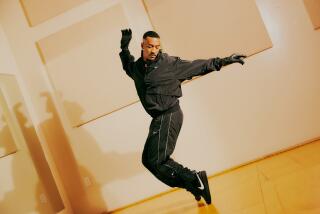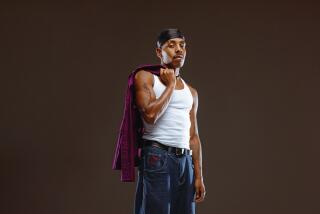‘It’s kind of like a game you play, only you do it with eight people and everybody has to win’
- Share via
By day, Wil Eades is an equipment shop supervisor of mechanics. At night, he dons Western garb and takes to the floor to call square dances from Riverside to New Zealand. For Eades and the swirling dancers he leads through intricate movements, the only thing square about square dancing is the starting position. It takes eight people to make a square. Starting this week, he is teaching a new class for beginners Wednesday nights through the Vista Parks and Community Services. Eades was interviewed by Times staff writer G. Jeanette Avent and photographed by Don Bartletti.
Square dancing has picked up a bad image. Many people think of it as very hokey. It’s been made fun of through the years. They think of square dancing as dancing to fiddle music around the barn and hay with hillbillies.
Things have changed a lot through the years and the dance is very, very modern. Most of the songs are country western and pop and include songs like “Splish Splash,” “Summertime Blues” and “Elvira.”
Square dance can be extremely complex, which has made it hard for beginners to go from the classroom to the dance floor. In the early days, the dances were very simple. It was mainly the dance of the early pioneers. The steps were things people could go to a social and in one night learn enough to dance. They didn’t have time for classes.
There are only about two or three dance calls such as “do se do” and “the promenade” still left from the old square dance calls. Today the movements have names like spin, chain and exchange the gears, and star through.
There are about 78 movements at the entry level to learn and at the advanced levels, a dancer will have learned about 200 steps which the caller can call out for them to dance at any time.
You need about five years of dance experience to be at that level. For people who just can’t get enough, there are challenge levels 1, 2, 3 and 4. There may be eight squares of people throughout the whole world who can dance at the Challenge 4 level.
I got the bug watching my older brother dance. He was having too much fun without me.
When I was younger, my wife tried to get me to dance but there was no way. I was like most men. If you say dance, men take off in the other direction. I always felt it made me look foolish. I didn’t want anything to do with it. But when I saw people square dancing, I thought this is really different.
At the square dance I went to with my brother, they were just ordinary people and they were just having the greatest time. I took a class, and a friend who was learning to be a caller used to take us out to the park on Sunday, put a quarter in the meter, turn on his sound equipment and call to us. I was 31 then and I’m 51 now. I’ve been dancing and calling ever since.
After a year of dancing, I decided I wanted to be a caller.
In high school, I was in the choir so I had a little singing background, although I’m not a great singer. We had an amateur night at our square dance club.
My first try at it I did it by memorizing calls from a record I had learned. My voice cracked, my legs shook. I thought I was terrible. There were only 16 people at the dance. It wasn’t like there were 1,600. It just took some getting used to. But I had the bug then. I thought, “this is fun.”
Calling is kind of an ego trip, although I wouldn’t call that first night an ego trip. It was a new challenge for me and it was something I really wanted to try to do. From there, it took a tremendous amount of devotion. You have to put in hours on hours of study time.
About 25 records come out each month especially for square dancing. I like to pick songs people can sing along with like “Summertime Blues.” One side of a record will have music and calling that a caller can learn from, and the other side will have just the music.
But nothing is memorized by the caller. Everything is impromptu. A caller puts the dance movements together in sequences that have a good flow. It’s up to the caller to put good choreography together. Callers want the dance to look good and feel good and be very danceable.
Anybody that can do a fast walk can square dance, but you’ve got to be able to listen and react. The caller tells the dancer what to do and he or she has to make the adjustment. The caller is two beats ahead of them at all times.
For advanced dancers, a caller can call any of the 200 movements as long as they flow. It’s a challenge. A caller will bring dancers back to their original partner at their starting position several times during a dance.
The caller is challenging the dancer to do everything right. This is what square dancing is all about. It’s kind of like a game you play, only you do it with eight people and everybody has to win. That’s why classes are so important. You can’t do a square dance without a class.
Since I started calling, I’ve called for dances everywhere from Sun City, Riverside to Christchurch, New Zealand. One year, I called 39 nights in a row. That was unusual, but for a long time I was calling as many as four nights a week.
But square dancing has probably been the best part of my life. I’ve met some of the nicest people in the world. People are so friendly that you can go to a square dance by yourself and feel comfortable.
More to Read
The biggest entertainment stories
Get our big stories about Hollywood, film, television, music, arts, culture and more right in your inbox as soon as they publish.
You may occasionally receive promotional content from the Los Angeles Times.










